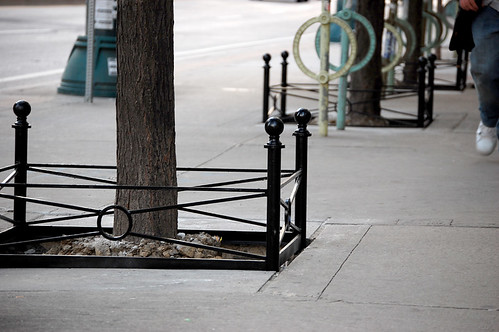
The base of tree, often referred to as a tree pit, is one of the small details of urban design that I have a strong fascination with.
Here in Toronto, we’ve seen a spike in the attention tree pits have received from residents and BIAs. Last summer at the corner of Spadina and Oxford, just east of Kensington Market, local merchants and residents removed the cement casings that are often found on top of the base of a tree. These cement “coffins” keep much needed water from seeping into the ground. These liberated tree pits changed the appearance and functionality of the corner in a dramatic way.
Further south on Spadina near King West, tree pits were renovated this summer (see photo above). The cement casings were removed. Soil to protect the roots were added, as were black cast-iron railings to keep pedestrians from walking on the root systems. These new features maybe the most attractive additions I’ve seen to a tree pit in Toronto.
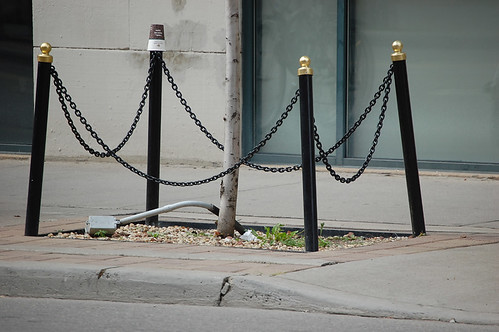
The tree pit seen above is on King West near Bathurst. This style of treatment is becoming more commonly used in Toronto: rock pebbles are placed at the base instead of soil, which is just as effective for protection and permeability. What I don’t like is the hanging chain and gold-plated knobs — its just plain tacky. Instead of using an attractive barrier (like the image at the top of the post) that hides it’s function, this version gives a pedestrian a fenced-off security feel.
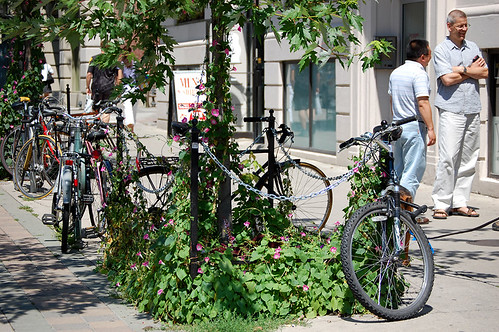
The same tree pit approach is used on Spadina just north of Queen (and just outside Spacing’s office). But the difference is huge: plants have been placed to grow up and around the barriers, lessening the fenced-off feeling I mentioned above. The poles and chains now serve a better purpose by doubling as a place to lock a bike.
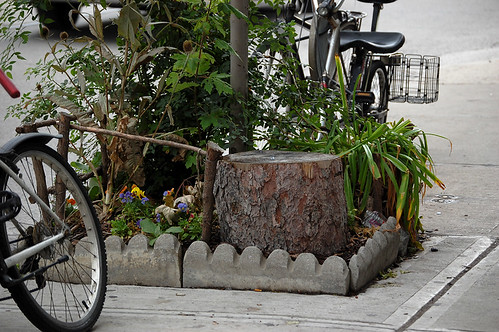
On Queen just west of Bathurst, tree pits have also been liberated and turned into small, playful gardens (photos above and below). Cement stones and wood fences are used to indicate the tree pit boundary in an attractive and charming way.
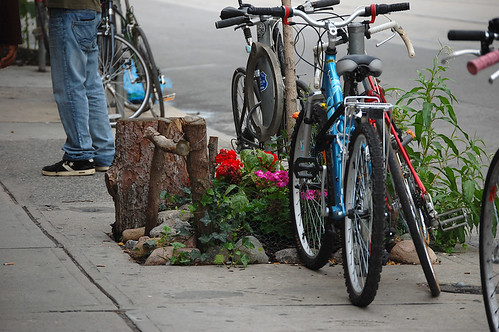
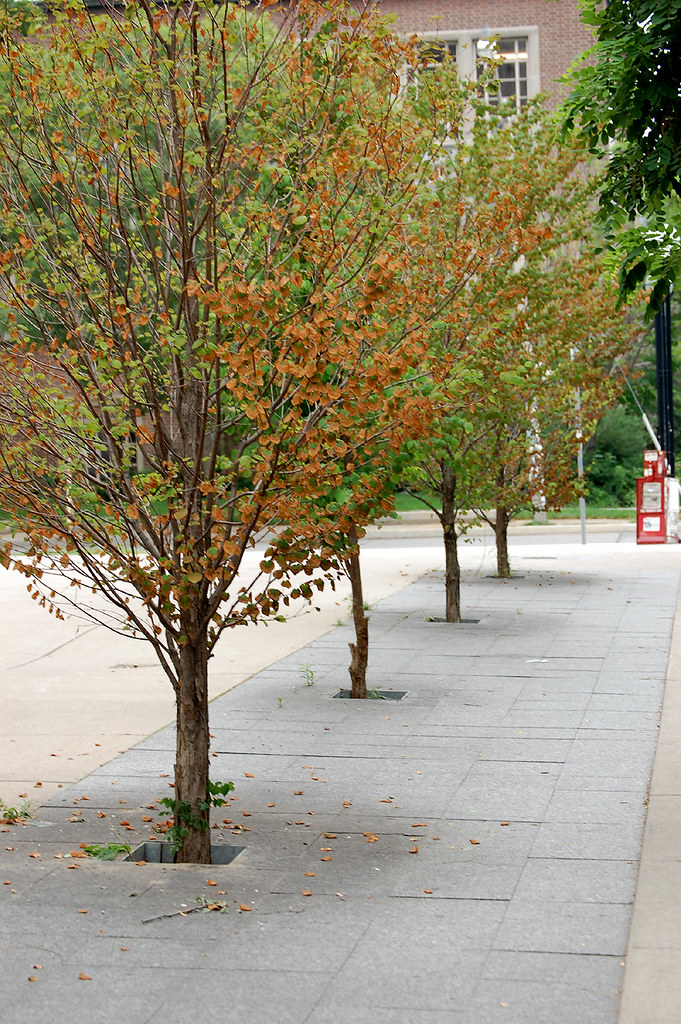
On St. George Street at U of T’s campus, streetside trees are usually placed in patches of grass. But there are a few tree pits like the one shown above. Sadly, this photo was taken in June — while all the other trees were in full bloom, this row of four trees were dehydrated and losing leaves. The small space at the base seems to be hindering the ability of these trees to be properly nourished.
Below are a handful of other tree pits I’ve seen in my recent travels.
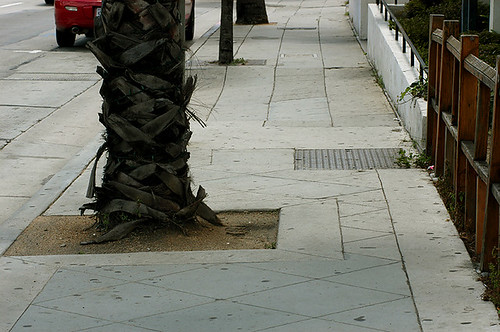
Los Angeles
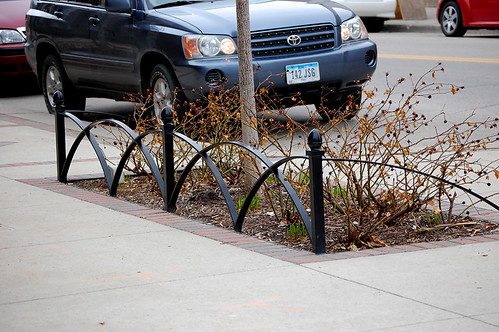
Des Moines, Iowa

Denver
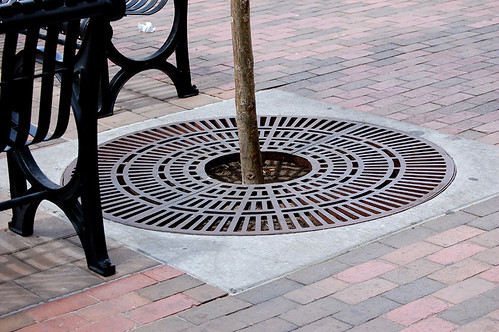
Albequerque, Nw Mexico
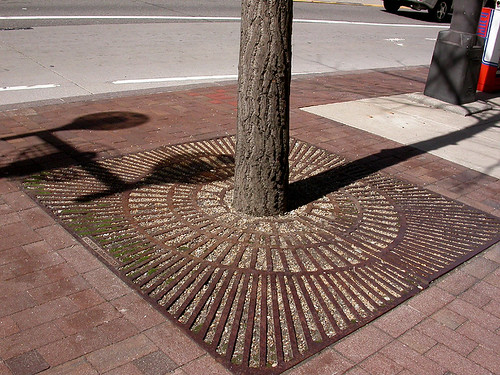
Columbus, Ohio
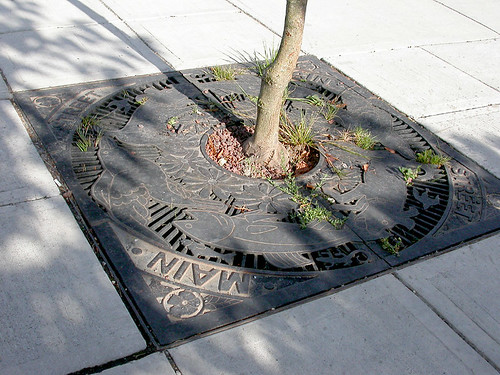
Vancouver
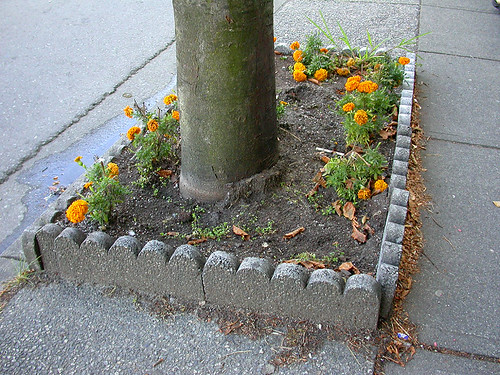
Vancouver
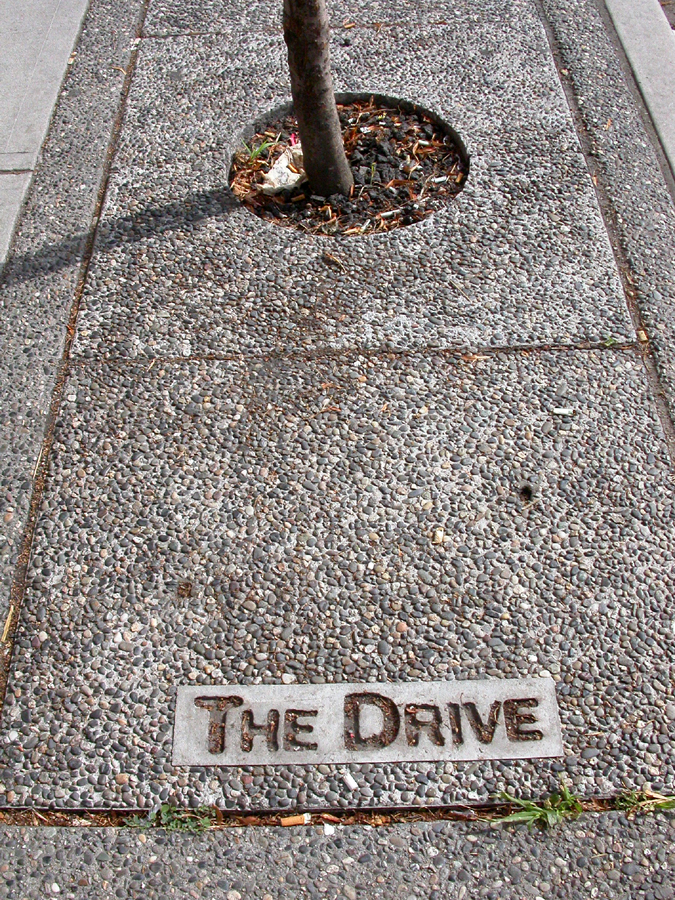
Vancouver

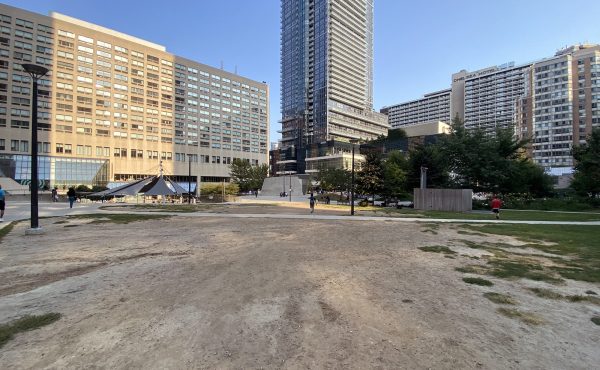


15 comments
That first Vancouver tree pit grate is really pretty!
I’ve also seen trees with benches encircling them, which allows water through while stopping people from stepping on the roots, and allows people a place to sit. I think there are a few of these at U of T’s St. George campus.
That’s funny, I was just working on tree pit guards in NYC today. Here are the design guidelines for 4 types of tree pit guards that Parks&Rec uses:
http://www.nycgovparks.org/sub_your_park/trees_greenstreets/images/TreePlantingStandards.pdf.pdf
Finally, Toronto seems to be getting with it. Better late to the party than never.
More tree pits, everywhere, please.
Great post!
I have a reservation about tree grates (ex: New Mexico and Ohio photos): if the rings are not cut as the trunk expands, the grate can girdle the tree.
I prefer guards like the Spadina near King West example at the beginning of your post. Trees NY has a list of good vs. poor tree pit guard design (http://www.treesny.com/trees_pitguards.htm).
I’m hoping to not see more of those hanging chain and gold-plated knobs seen in the photo.
The trees in the pits are the lucky ones. What kind of design surrounds them is a nice consideration. It’s those poor hero trees on Bloor, stuffed bonsai-style into miniature concrete aboveground boxes, that I depress me. Those trees really try hard. They deserve better. And good design.
Excellent post!! The only downside (mentioned in the NYC website suggested by Georgia) is the obstacle created by fenced-in tree pits. Considering Toronto’s generally narrow sidewalks, fenced in tree pits are probably too luxurious for most streets.
One of the crazy things I’ve thought the city should try are portable trees on prestige streets. Grow them in very large containers (sidewalk width) that slot into appropriately sized pits in the sidewalk.
These trees could be put out in the spring to beautify and shade the street during the warm months, then pulled out before heavy frosts. The pits would obviously be covered after the containers are removed!
The trees would be trucked to an over-wintering site where the soil in the containers could be amended/cleaned/aerated and trees stored until spring.
This would relieve street trees of the (major) problems caused by road salt during the winter, and free up sidewalk space for piled up snow.
What about permeable concrete for sidewalks where there isn’t enough room for a full tree-box?
It’s a relatively new product so I haven’t heard of instances of it in use, but it would allow water to get through to the roots, protect roots from being stepped on, and unlike the metal grates could probably be removed a little bit at a time to accommodate trunk growth.
Chicago has nice ones downtown.
I would love to see the city make low rise beds around the trees and allow for individuals/businesses to sponsor them. Even plant and maintain them. Even make it a competition and have people vote on their favorite one.
I loved the ones in downtown NYC and Chicago, but they were definitely designed for enormous sidewalks. Strolling in those cities’ cores is so luxurious — I actually feel like the city thought of me.
Just thought I would point out that the roots of trees extend well beyond the leaves or crown of the tree. In fact in a healthy tree it is the area beyond the crown where the roots gather in most of their water and nutrients. Consider the natural design of the crown. It gathers water and moves it out away from the base of the tree, which is why we stand under them during the rain. The roots grow in response to that. So from the edge of the crown or the drip line as it is also know, is where the tiny little roots that gather water and nutrients grow most abundantly.
Tree pits are great but we have to think bigger.
Those U of T 9-inch squares are sadistic – very thoughtless design. Obvious cause and effect in that photo. But still, couldn’t the grounds staff water the poor things? Maybe they’re in those concrete coffins below ground anyway.
Toronto has similar tree pits to one in the Albequerque photo on Gould St. (Ryerson)…and probably elsewhere in the city. They look really nice, especially when built into decorative brickwork instead of standard concrete sidewalks. And the trees seem much, much happier too.
25 years ago, my parents bought a condo in a redevelopped steel mill in Montréal. When the city eventually put the sidewalks, they put the perfectly normal, customary tree pits planted with the generic, plain vanilla ordinary silver maples you see all over the place.
Three of those trees were on the side of their condo (since sold).
Everytime my mother cooked vegetables, she kept the cooking water, and poured it on the roots of the trees. 25 years later, those three trees are twice the size of the other trees planted at the same time.
I wonder if the city horticulturists scratch their heads about why those trees are much healthier than the rest… 🙂 🙂 🙂 🙂
* * *
OTOH, a friend of mine, when he was a city councillor caught several merchants (little merchants are always at the forefront of social advance and englightened ideas) pouring battery acid on trees, in order to kill them, because they were “masking their store signsâ€Â.
Are those merchants the Montréal cousins of the Toronto ones who opposed the St-Clair tramline? Glad they got caught.
I remember a jeweller in downtown Montréal yelling at me for parking my bicycle outside his business – not on his property, on the sidewalk, attached to a street sign or parking meter – because my bicycle supposedly “detracted” from his business…
Nicer to hear about your mum and her cooling water.